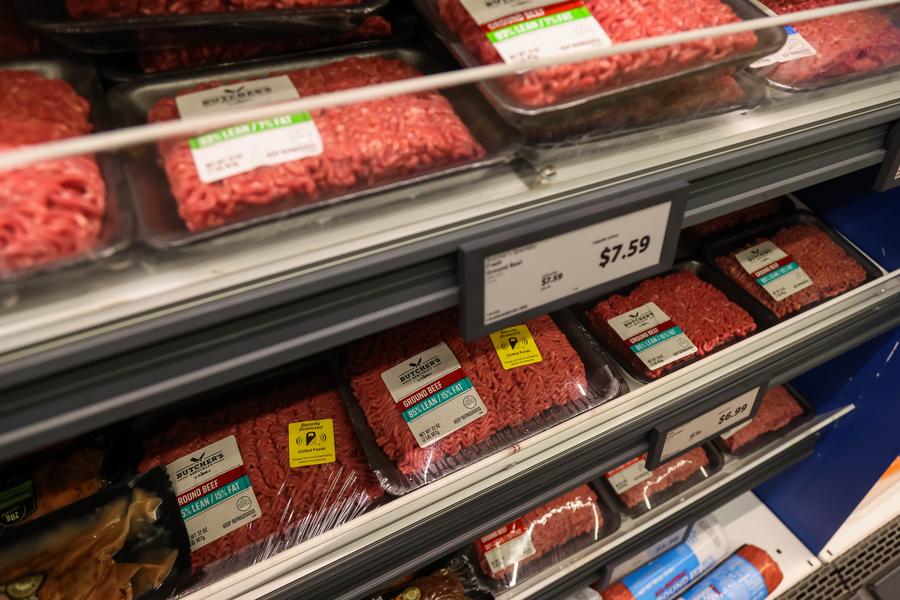


People shop at a retail store in New York, the United States, on Aug. 12, 2025. (Photo by Michael Nagle/Xinhua)
In Florissant, a suburb of St. Louis, beauty store co-owner Trinita Rhodes said her shelves tell the story of how tariffs have reshaped prices. Since the United States imposed additional duties on Chinese imports in April, she said, many items have jumped sharply in retail prices and have not fallen back, even after Washington announced a 90-day truce with Beijing.
WASHINGTON, Aug. 13 (Xinhua) -- U.S. President Donald Trump's tariff stick has pushed up levies on foreign goods to the highest levels in nine decades, imposing heavier costs on American households and businesses.
The new customs duties, which took effect in early August, now apply to almost every U.S. trading partner. Researchers at Yale University estimate the average tax rate on imports has jumped from just over 2 percent in January to more than 18 percent today, the highest since the 1930s.
PRICE HIKES
While the levies are collected from importers, economists say much of the eventual cost will be paid by shoppers through higher prices. Some categories could see especially sharp increases.
Economic modeling from Yale's Budget Lab suggests retail prices for shoes may climb by roughly 40 percent and apparel by 37 percent once the full impact goes through supply chains. Everyday goods such as fruits, kitchen appliances and automobiles are also to rise, with new cars potentially costing thousands more.

This photo taken on Aug. 12, 2025, shows beef for sale at a grocery store in New York, the United States. (Photo by Michael Nagle/Xinhua)
Small enterprises across the Midwest are already contending with sharp cost inflation. In St. Louis, Missouri, for instance, retailers report supplier price increases of up to 30 percent, covering everything from bicycles and beauty products to board games, a Financial Times survey found.
Standout examples include washing machines and wine refrigerators, whose prices have surged by as much as 35 percent. Even domestically made goods are not spared, as manufacturers pass on elevated input expenses, including for imported steel and aluminum.
One business owner, Mike Weiss, who runs a chain of bike shops in the city, typifies the struggle. "Normally, we would reprice things on an annual basis, not daily," Weiss told the newspaper. "The goalposts keep moving."
In Florissant, a suburb of St. Louis, beauty store co-owner Trinita Rhodes said her shelves tell the story of how tariffs have reshaped prices. Since the United States imposed additional duties on Chinese imports in April, she said, many items have jumped sharply in retail prices and have not fallen back, even after Washington announced a 90-day truce with Beijing.
COSTS SHIFT TO CUSTOMERS
Businesses once shouldered much of the tariff hit. Goldman Sachs estimates that through June, companies absorbed about 64 percent of the extra costs, with consumers covering roughly 22 percent and foreign exporters 14 percent. But the bank expects the consumer share to soar to 67 percent by October. Domestic manufacturers, facing less competition from imports, may also raise their prices.
Goldman projects that if tariffs remain in place, the Federal Reserve's preferred inflation gauge -- the core personal consumption expenditures price index -- will finish the year at around 3.2 percent, compared with 2.4 percent without the duties. The July reading of core consumer inflation was already running at 3.1 percent.
Analysts say the overall average tariff rate -- now 18.6 percent -- rivals that imposed under the Depression-era Smoot-Hawley Tariff Act. The higher costs are showing up not only in finished goods but also in industrial inputs like steel and aluminum, which feed into U.S. production and construction.
For now, falling energy prices and inventories built up before the tariffs are helping keep overall inflation in check. But as stockpiles run down and import contracts renew at higher rates, economists warn that the upward pressure on prices will intensify. The longer the tariffs last, the more they risk weighing on consumer spending and slowing economic growth.
That puts the Federal Reserve in a bind. The agency often faces calls from the White House to cut down interest rates to support a faltering labor market, even as tariff-driven inflation stays above the 2 percent target. For small-business owners like Weiss, the policy debate is distant from the day-to-day reality: either swallow the higher costs or pass them on to customers, despite that both choices carry a price.
点击右上角![]() 微信好友
微信好友
 朋友圈
朋友圈

请使用浏览器分享功能进行分享
